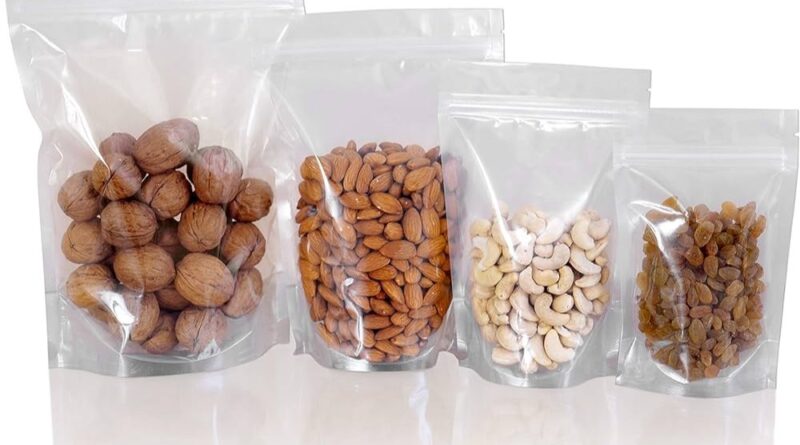Snack Packaging Bags: Balancing Functionality and Brand Appeal
Snack packaging is more than just a protective layer for the product inside; it’s a key element in attracting consumers, ensuring product freshness, and enhancing the overall customer experience. With the growing competition in the snack industry, the importance of balancing functionality with brand appeal has never been greater. The packaging must meet various practical needs while also standing out on the shelf to capture the attention of potential buyers. Let’s explore how snack packaging bags can successfully balance functionality and brand appeal.
The Role of Functionality in Snack Packaging
Functionality is the primary concern when designing snack packaging. A packaging bag must protect the product, preserve its quality, and ensure that it remains fresh until consumed. Here are some of the key functional elements that snack packaging must address:
1. Protection from External Elements
Snacks are often susceptible to damage from external factors such as moisture, light, air, and contaminants. Proper packaging provides a barrier to these elements, helping to maintain the integrity of the product. Packaging materials such as multi-layer films, foil pouches, and vacuum-sealed bags are designed to keep oxygen, moisture, and UV light out, preserving the snack’s taste, texture, and shelf life.
2. Convenience and Portability
Consumers are increasingly looking for packaging that fits into their busy lifestyles. Snack packaging bags must be convenient to open, reseal, and carry. Resealable zippers, easy-tear openings, and compact sizes make it easier for consumers to enjoy snacks on the go while ensuring they remain fresh for longer. Additionally, lightweight and flexible materials make snack bags portable, which is an important consideration for busy individuals or families.
3. Preservation of Freshness
One of the most critical functions of snack packaging is maintaining freshness. Snacks like chips, nuts, and dried fruits are particularly sensitive to staleness, which can negatively affect their flavor and texture. Packaging solutions with advanced barrier properties—such as vacuum-sealing, nitrogen flushing, and resealable closures—play a major role in extending shelf life and keeping snacks crisp, crunchy, and flavorful.
4. Cost-Effectiveness
While the appearance of packaging is important, manufacturers must also consider the cost of materials and production. Choosing cost-effective yet durable packaging options is key to maintaining profitability while still offering functional and high-quality packaging. Flexible packaging materials like stand-up pouches are not only functional but are also relatively inexpensive, allowing manufacturers to keep production costs low.
The Importance of Brand Appeal in Snack Packaging
Brand appeal is a crucial element that can make or break a product’s success on the shelf. In a crowded snack market, packaging serves as a silent salesperson, communicating the brand’s identity, values, and product quality. The right packaging can make a significant difference in consumer purchasing decisions. Here’s how snack packaging bags contribute to brand appeal:
1. Attractive Design and Visual Impact
The design of snack packaging is often the first thing that catches a consumer’s eye. Bright colors, engaging graphics, and unique shapes can help a snack bag stand out in the aisle. A well-designed package should convey the brand’s personality and values, whether it’s emphasizing health-conscious ingredients, indulgence, or fun and enjoyment. Custom-designed packaging that aligns with a brand’s identity can create an emotional connection with consumers, increasing brand loyalty.
2. Clear Product Information
In addition to being visually appealing, packaging must also communicate important information clearly and concisely. Consumers want to know what they’re buying, and providing clear details about the product’s ingredients, nutritional content, and benefits can encourage a purchase. Labels should be easy to read, with a balance between aesthetic appeal and informative content. Highlighting certifications, such as organic or gluten-free, can also add to the packaging’s appeal.
3. Eco-Friendliness and Sustainability
Consumers are becoming more environmentally conscious, and sustainable packaging is now a key factor in brand appeal. Packaging that is recyclable, biodegradable, or made from renewable resources shows that the brand cares about reducing its environmental footprint. Eco-friendly packaging options like compostable bags or materials made from recycled content can enhance a brand’s image and appeal to sustainability-minded consumers.
4. Differentiation from Competitors
With so many snack options on the market, differentiating a brand from its competitors is crucial. Unique packaging, whether through the shape of the bag, the choice of material, or innovative features like stand-up pouches or easy-tear openings, can set a brand apart. Packaging that offers a fresh, unique approach will likely catch the consumer’s attention and give the brand an edge over others in the same category.
Balancing Functionality with Brand Appeal
While functionality and brand appeal are both essential, striking the right balance between the two is key to successful snack packaging. Here are some strategies to ensure both elements are considered:
1. Choosing the Right Material
The material chosen for snack packaging should not only serve its protective purpose but also complement the overall brand image. For example, luxury snack brands may opt for high-end materials with a sleek, glossy finish to communicate premium quality, while eco-friendly brands may use kraft paper or compostable films to align with sustainability values. The packaging material should also be durable enough to protect the snack while adding visual appeal.
2. Innovative Design Features
Innovative packaging features, such as resealable zippers, tear notches, or transparent windows, can enhance both functionality and brand appeal. A transparent window allows consumers to see the product inside, which can create a sense of trust and transparency, while also showcasing the snack’s freshness. Adding functional elements like easy-opening features or portion-control packaging can also make the product more attractive to consumers looking for convenience.
3. Consistency Across Product Lines
For brands that offer multiple snack products, ensuring packaging consistency across product lines is important for building brand recognition. Using a similar color palette, logo placement, and design elements across all products can create a cohesive brand identity that resonates with consumers. However, it’s important to allow room for differentiation between product categories, ensuring that each product’s packaging is tailored to its specific attributes (such as size or flavor).
4. Consumer Feedback and Market Testing
To ensure that both functionality and brand appeal are met, it’s essential to gather consumer feedback and conduct market testing. Understanding what consumers value in snack packaging—whether it’s ease of use, aesthetic design, or product freshness—can guide packaging decisions. Regularly testing packaging designs with target consumers helps refine the balance between form and function, ensuring that the end result resonates with the audience.
Conclusion
Snack packaging plays a vital role in preserving freshness, ensuring convenience, and enhancing the consumer experience. Balancing functionality with brand appeal is essential to creating packaging that not only protects the product but also draws consumers in. By selecting the right materials, designing innovative features, and ensuring alignment with brand identity, manufacturers can create snack packaging that stands out on the shelf while maintaining the essential protective qualities that keep snacks fresh and enjoyable. In the ever-evolving snack industry, the right packaging is a crucial element for success.




